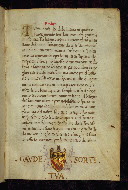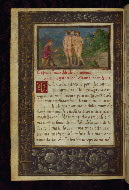Home > Digitized Walters Manuscripts
This document is a tranformation of a TEI P5 XML manuscript description incorporating images. If you have trouble reading special or non-Latin characters on this page, please make sure you have appropriate Unicode fonts installed and an up-to-date web browser.
Walters Ms. W.478, Treatise on cosmetics
Browse images (Browse images in a new window) | TEI in XML format
W.478
Treatise on cosmetics
Vernacular: Cosmetica, written in pencil on interior paste down
This Italian manuscript, written in Venetian dialect, was produced ca. 1500, and contains various recipes and remedies for the wellbeing and beauty of women. This text, like most cosmetic treatises in the vernacular, is addressed specifically to a female audience. The text's focus on beauty and appearance is emphasized by the miniature on its opening page, where we see the Judgement of Paris. The Trojan hero Paris was asked to judge a beauty contest between Aphrodite, Hera, and Athena. He chose Aphrodite because she promised him the hand of Helen, known as the most beautiful woman in the world. Although the origin of this text is unknown, it follows in the tradition of those which focus specifically on cosmetics. One such example is the 12th century "Trotula" text that is believed to have originated in Salerno (Italy) and is comprised of three distinct works. One of them (De ornatu mulierum) was dedicated to cosmetics, whereas the other two dealt with obstetrics/gynecology and women's diseases respectively. The "Trotula" corpus was immensely popular and survives in nearly 200 copies in both Latin and various vernacular translations. The Walters treatise, on the other hand, survives only in one partial copy at the Wellcome Library (MS 531) in London, which is missing the prologue as well as a significant portion of the book itself.
Ca. 1500
Italy
Book
Scientific -- Medical
The primary language in this manuscript is Italian.
Parchment
Lightweight cream parchment
Foliation: 42
Modern pencil and black ink foliation, upper right corners, rectos; the first page and last page are flyleaves that have been foliated
Formula: Quire 1: 2, with modern(?) parchment flyleaf hooked (fols. 1-3); Quires 2-5: 10 (fols. 4-33), Quire 6: 10, with last two folios cancelled and stubs of adjoining leaves, fols. 34 and 35, hooked to fol. 41; fol. 41 is hooked to fol. 36; modern parchment flyleaf hooked around quire, and foliated as fol. 42 (fols. 34 to 42)
Catchwords: Found throughout, written vertically at the right edge of the lower margin, versos
Comments: Pastedowns are conjoint with facing flyleaves; the one at the beginning of the manuscript is hooked in, whereas the one at the end is tipped in
11.0 cm wide by 16.8 cm high
7.7 cm wide by 11.4 cm high
- Columns: 1
- Ruled lines: 21
- Title: Ars profumatoria vel cosmetica
- Text note: On fol. 44r is written in modern (?) black ink: "Pecorio (?) pofiro (?) in questo proposito (?) quando fossero del medesimo stato, come prima"
- Hand note: Written in humanist script
- Decoration note: Fol. 4r: heraldry of the first owner (?); fol. 5v: miniature of judgement of Paris, full illustrated purple border, decorated initial; decorated initial with gold leaf and ink detail before each remedy (section) as on fol. 7r; title of each remedy in red ink; text in black ink
- Title: Tavola dele cose scripte in questo libro
- Rubric: Tavola dele cose scripte in questo libro
- Incipit: Savon liquido napolitan
- Contents: List of the different remedies found in the text
- Title: Epylogo
- Rubric: Epylogo
- Incipit: Tutte le cose che dala natura in questo inferior mondo
- Contents: Prologue to main text
- Title: Capitolo primo deli odori
- Rubric: Capitolo primo deli odori in comuni: savon liquido che si chiama Napolitan
- Incipit: Tolli cennere de cervo parti doi calcina
- Contents: Main body of the text composed of two chapters (first begins at fol. 5v, second at fol. 24r) with recipies and remedies for the wellbeing and beauty of women
fol. 4r:

- Title: Heraldry
- Form: Heraldry
- Text: Prologue to Ars profumatoria vel cosmetica
- Label: This heraldry perhaps belongs to the first owners of the manuscript. In the main field of the heraldry an eagle sable with outstretched wings is depicted with three "bends gules" (stripes angled to the right) in red and gold below. On either side of the heraldry in purple ink is a foliate motif along with the inscription "Gaude Tua Sorte" in gold leaf.
fol. 5v:

- Title: Miniature of the Judgement of Paris
- Form: Small miniature and full illuminated border
- Text: Main text of remedies and recipes in Ars profumatoria
- Label: This page contains a miniature depicting the Judgement of Paris. The Trojan hero Paris was asked to judge a beauty contest between Aphrodite, Hera, and Athena. He chose Aphrodite because she promised him the hand of Helen, known as the most beautiful woman in the world. The abduction of Helen from her husband Menelaus, king of Sparta, was the impetus for the start of the Trojan War. This page is also illuminated with a full purple border and decorated with Classicizing elements (foliate motifs, vessels, etc.) in both gold and white/silver.
The binding is original.
Bound in Italy, ca. 1500; brownish-red goatskin over wooden boards; gold and blind tooling for the frames and centerpiece design; two strap clasps re-inserted in the 20th century, composed of modern bronze over leather with heraldic (?) decoration; evidence of a 20th century re-sewing of the quires
Created in Venice ca. 1500
Henry Walters, Baltimore, purchased from Leo S. Olschki (bookseller, Florence) before 1931
Walters Art Museum, 1931, by Henry Walters' bequest
De Ricci, Seymour, and W. J. Wilson. Census of Medieval and Renaissance Manuscripts in the United States and Canada. Vol. 1. New York: H. W. Wilson Company, 1935, p. 828, cat. no. 426.
Green, Monica H. "The Development of the Trotula." In Revue d'Histoire des Textes 26 (1996): 119–203.
Green, Monica H. Women's healthcare in the Medieval West: texts and contexts. Aldershot: Ashgate, 2000.
Principal cataloger: Berlin, Nicole
Cataloger: Walters Art Museum curatorial staff and researchers since 1934
Editor: Herbert, Lynley
Conservator: Quandt, Abigail
Contributors: Berlin, Nicole; Emery, Doug; Tabritha, Ariel; Wiegand, Kimber
The Walters Art Museum
Licensed for use under Creative Commons Attribution-NonCommercial-ShareAlike 3.0 Unported Access Rights, http://creativecommons.org/licenses/by-nc-sa/3.0/legalcode. It is requested that copies of any published articles based on the information in this data set be sent to the curator of manuscripts, The Walters Art Museum, 600 North Charles Street, Baltimore MD 21201.